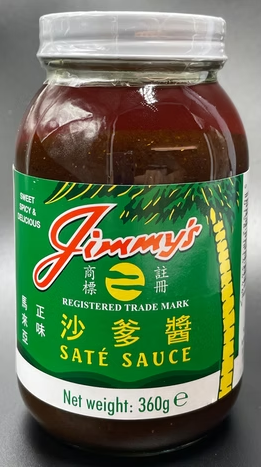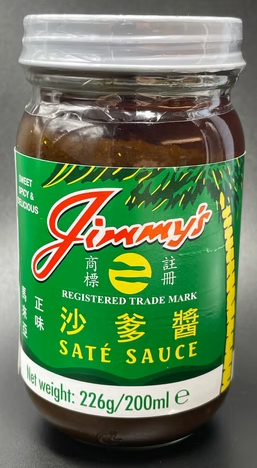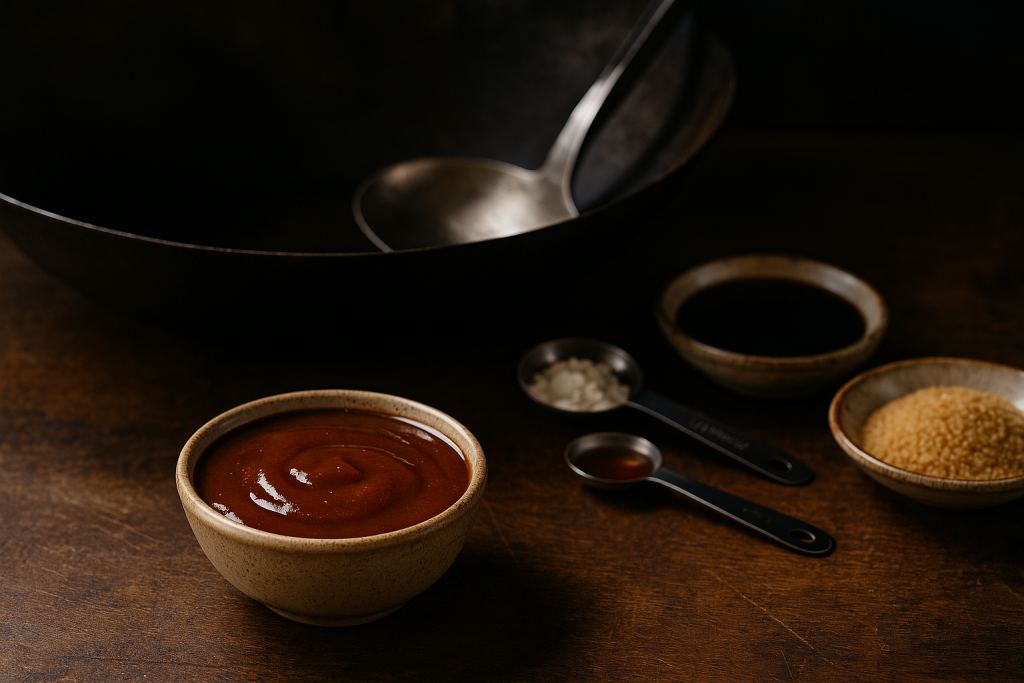Jimmy’s Satay Sauce Recipe – the 10-Minute Fakeaway You’ll Actually Use
You’ve seen the jar on Asian shop shelves and TikTok reels. Jimmy’s Saté (Satay) Sauce is the not-so-secret shortcut many UK takeaways use for that nutty, savoury, slightly sweet sauce. The roots are Southeast Asian – Indonesia, Malaysia, Singapore – but the jar most of us buy is made in Hong Kong, and it’s become a backbone for Chinese-takeaway-style satay here. Honestly, that mix of traditions is why it’s so versatile.


What Jimmy’s Saté Sauce Actually Is
Jimmy’s is a cooked paste of rapeseed oil, peanuts (about 19%), soy sauce, sugar, spring onion, garlic, shrimp, curry powder and chilli. In plain English – fat for body, peanuts for flavour, soy for salt, aromatics for depth, spices for warmth. It’s punchy straight from the jar, which is why a little goes a long way. Allergy heads-up: it contains peanuts, soy, wheat and crustaceans. Possibly not the sauce to wing without reading the label.
Two Legit Styles (Pick Your Lane)
Here’s where opinions split, and I won’t hedge.
- Coconut-forward satay (Singapore/Malaysia style): smooth, a bit richer. Many home cooks add coconut milk and even extra crushed peanuts. Jimmy’s own UK site shares a version like this.
- Cantonese takeaway saté: leaner, more soy-savory, no peanut butter or coconut. That’s the style some Hong Kong cooks insist on. Both are good; they’re just different.
Core Pantry Recipe (Coconut Route)
This makes about 500 g of pourable sauce – enough for noodles for four, or dipping for a tray of skewers.
- 75 g Jimmy’s Saté Sauce
- 150 ml water
- 100 g crushed salted peanuts (optional but lovely)
- 100 ml coconut milk
- 25 g brown sugar
Method:
Whisk paste and water in a small pan. Add peanuts, coconut milk and sugar. Simmer 3–5 minutes until slightly thick. Thin with water if needed. Taste – you may want a pinch of salt or a squeeze of lime. That’s it. Honestly, it’s harder to overthink than to cook.
Cantonese Takeaway Style (No Coconut)
When you want that glossy, savoury saté that clings to beef or chicken in a wok:
- 2 heaped tbsp Jimmy’s Saté Sauce
- 150 ml hot water or chicken stock
- 1 tsp light soy
- ½ tsp sugar (taste first; the jar is sweet already)
- 1 tsp cornflour mixed with 1 tbsp water (optional, for extra cling)
Method:
Stir paste with hot water/stock until smooth. Add soy and sugar. Bring to a simmer 1–2 minutes. If you like it thicker, add the cornflour slurry and bubble 30 seconds. Use straight away in a stir-fry or as a drizzle. (Purists will cheer – no coconut, no extra peanut).

How to Use It – Three Fast Wins
- Chicken skewer dip: Grill or air-fry skewers, warm the coconut-route sauce and finish with chopped coriander and peanuts.
- 15-minute noodle toss: Stir-fry veg and leftover meat, add the no-coconut sauce, toss with cooked noodles, splash of sesame oil.
- Satay fried rice: A spoon of Jimmy’s into your usual egg fried rice is outrageously good for the effort. Possibly addictive.
My Straight Talk on Tweaks
- Peanut butter: If you want thicker, add a spoon. If you’re chasing Cantonese takeaway notes, skip it. Both paths have fans.
- Coconut milk: Great for the Southeast Asian lane; unnecessary for the Cantonese one. Use less than you think – it can drown the aromatics.
- Soy + lime: A dash of soy sharpens salt; a squeeze of lime lifts the finish.
- Heat: Jimmy’s has mild warmth. For kick, stir in chilli oil at the end.
Ingredient and Origin Notes (So You Can Shop Smart)
Multiple UK retailers list near-identical labels: rapeseed oil, peanuts 19%, soy sauce, sugar, spring onion, garlic, shrimp, curry powder, chilli. That shrimp is why vegans will need another brand or a homemade satay. Origin is Hong Kong production, though the recipe story nods to Malaysia. Check jars for current allergen wording.
Stir-Fry Timing – Avoid the Split
Satay sauces can split if hammered on high heat. Solution is simple:
- Cook protein and veg first.
- Add sauce at the end over medium heat.
- Toss just until glossy and hot, then off the heat.
If it still looks oily, whisk in a splash of hot water. Don’t panic – emulsions are fickle; water brings them back together.
Make-Ahead, Storage, Safety
Unopened jars are ambient. Once opened, keep refrigerated and use within about a month. If you’ve made a batch of finished sauce, it will hold 3–4 days in the fridge. Reheat gently with a spoon of water. Don’t let it boil hard – you’ll split the fat.
Troubleshooting – Quick Table
| Problem | Likely cause | Fix |
| Too thick | Simmered too long | Loosen with hot water or stock. |
| Too sweet | The jar carries sugar | Add soy, lime, or a pinch of salt. |
| Oily split | Heat too high | Whisk in hot water off the heat. |
| Flavour dull | Coconut masked it | Reduce coconut next time; add a touch of soy. |
If You Want to Go Deeper
Sous Chef’s overview is handy if you’re new to Jimmy’s – quick background and serving ideas. It’s not gospel, but it tracks with how UK cooks use it at home. The brand’s own pages cover history and the Hong Kong production line, which clears up the “Is it Malaysian or Chinese?” confusion. The short answer is both – by recipe roots and by manufacturing.
Final Word
Jimmy’s isn’t a museum piece. It’s weeknight cooking that tastes like you tried harder than you did. Pick a lane – coconut-smooth or Cantonese-savory – and commit. Keep the heat moderate, taste as you go, and don’t be shy with water to adjust consistency. Honestly, that’s the whole trick. The jar does the heavy lifting; you just steer.
